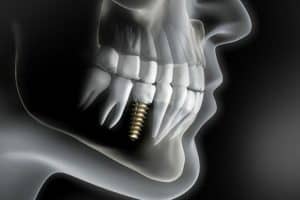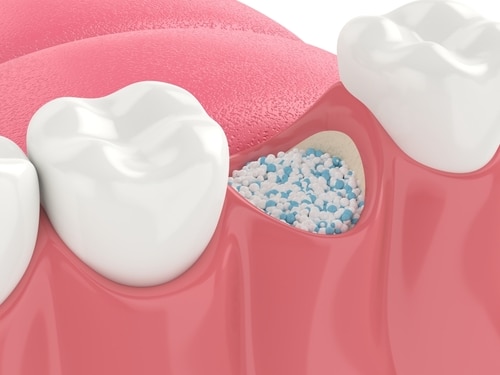The Importance of Supplemental Procedures

Dental implants are prosthetic tooth roots that provide a strong foundation for fixed or removable replacement teeth. They are a popular and effective long-term solution for individuals who have lost one or more teeth. Dental implant procedures involve the surgical placement of titanium posts into the jawbone, followed by the attachment of custom-made artificial teeth. While dental implants have a high success rate, supplemental procedures can play a significant role in the outcome of the implant process. At Genesis Dental, our Flower Mound, TX dentist, Dr. Madeleine Zhao, offers effective supplemental procedures to ensure dental implant success.
For optimal dental implant success, contact Genesis Dental by calling (972) 355-2424.
What are Supplemental Procedures?
Supplemental procedures are additional treatments or interventions performed before, during, or after dental implant placement to optimize the implant’s success rate and enhance the overall outcome of the procedure. These procedures are aimed at addressing specific issues related to bone quality, quantity, and surrounding soft tissues, which can impact the stability and longevity of dental implants.
Types of Supplemental Procedures
Bone Grafting
Insufficient bone volume or density in the jaw can pose a significant challenge for successful implant placement. Bone grafting involves augmenting the existing bone structure by transplanting bone tissue from another part of the body or using synthetic materials. This procedure promotes bone regeneration and creates a more stable foundation for the implant.
Sinus Lift
When replacing upper back teeth with dental implants, the proximity of the sinus cavity can limit available bone for implantation. A sinus lift, or sinus augmentation, involves lifting the sinus membrane and placing bone graft material beneath it to increase the height of the upper jawbone. This creates adequate space for implant placement and reduces the risk of implant failure.
Ridge Augmentation
After tooth loss, the jawbone may resorb or shrink, resulting in a diminished ridge or uneven bone surface. Ridge augmentation involves building up the ridge using bone grafts or other materials to restore its natural contour and thickness. This procedure improves the aesthetics and functional stability of dental implants.
Soft Tissue Grafting
Insufficient gum tissue or inadequate keratinized tissue around dental implants can lead to aesthetic concerns, compromised implant stability, and increased susceptibility to peri-implant diseases. Soft tissue grafting techniques, such as connective tissue grafts or free gingival grafts, are employed to augment the gingival tissue around implants, enhancing their appearance and long-term health.
Benefits of Supplemental Procedures
Supplemental Procedures have various benefits including:
- Enhanced Implant Stability: Supplemental procedures address underlying issues, such as inadequate bone volume or compromised soft tissue integrity, ensuring optimal conditions for implant placement. This results in improved implant stability and integration with the surrounding tissues, reducing the risk of implant failure.
- Improved Aesthetics: By augmenting bone and soft tissue, supplemental procedures help create a more natural and harmonious appearance of the dental implant restoration. Adequate tissue support and proper contouring contribute to a pleasing smile and facial esthetics.
- Long-Term Durability: Strengthening the underlying bone structure and soft tissues increases the resilience of dental implants against functional forces and occlusal stress. As a result, implants supported by supplemental procedures exhibit greater longevity and resistance to complications over time.
- Preservation of Oral Health: Addressing bone deficiencies and soft tissue deficiencies not only promotes the success of dental implants but also preserves the overall health of the oral cavity. Properly positioned and supported implants contribute to maintaining adjacent teeth, preventing bone loss, and minimizing the risk of periodontal diseases.
Why You May Require Supplemental Procedures?

Before undergoing dental implant placement, you may require a supplemental procedure to address specific or structural deficiencies that could compromise the success of the implant. There are several scenarios where supplemental procedures may be necessary, including:
- Insufficient Bone Volume: If you have experienced bone loss in the jaw due to factors such as periodontal disease, trauma, or long-term tooth loss, there may not be adequate bone volume to support the implant securely. In such cases, bone grafting procedures can augment the existing bone or regenerate new bone to create a stable foundation for the implant.
- Low Bone Density: Even if there is sufficient bone volume, the quality or density of the bone may be insufficient to support the implant long-term. Supplemental procedures such as bone grafting or ridge augmentation can improve bone density, reducing the risk of implant failure and ensuring better integration with the surrounding tissues.
- Sinus Proximity: When replacing missing upper back teeth, the sinus cavity may encroach upon the available bone space, making implant placement challenging. A sinus lift procedure elevates the sinus membrane and adds bone graft material beneath it to create adequate vertical space for implant placement, minimizing the risk of sinus complications.
- Uneven Ridge or Gum Levels: Following tooth loss, the jawbone may resorb unevenly, resulting in an irregular ridge shape or uneven gum levels. Ridge augmentation and soft tissue grafting procedures can help correct these issues, creating a more favorable environment for implant placement and optimizing aesthetic outcomes.
- Lack of Keratinized Tissue: Adequate keratinized tissue around dental implants is crucial for maintaining gingival health and stability. If there is insufficient keratinized tissue, soft tissue grafting techniques can be employed to augment the gingival tissue around the implant site, reducing the risk of complications such as recession or peri-implantitis.
- Previous Surgical Complications: In cases where previous dental surgeries or trauma have compromised the bone or soft tissue integrity, supplemental procedures may be necessary to correct these issues before proceeding with implant placement. This ensures a favorable surgical environment and reduces the likelihood of complications during and after the implant procedure.
Improve Dental Implant Success at Genesis Dental
The success of dental implants can be significantly enhanced through the incorporation of supplemental procedures that address bone health, periodontal wellness, and overall healing. By recognizing the importance of these supplementary interventions and working closely with your Flower Mound dentist, you can maximize the likelihood of achieving long-term success. Schedule a consultation at Genesis Dental by giving us a call at (972) 355-2424.
